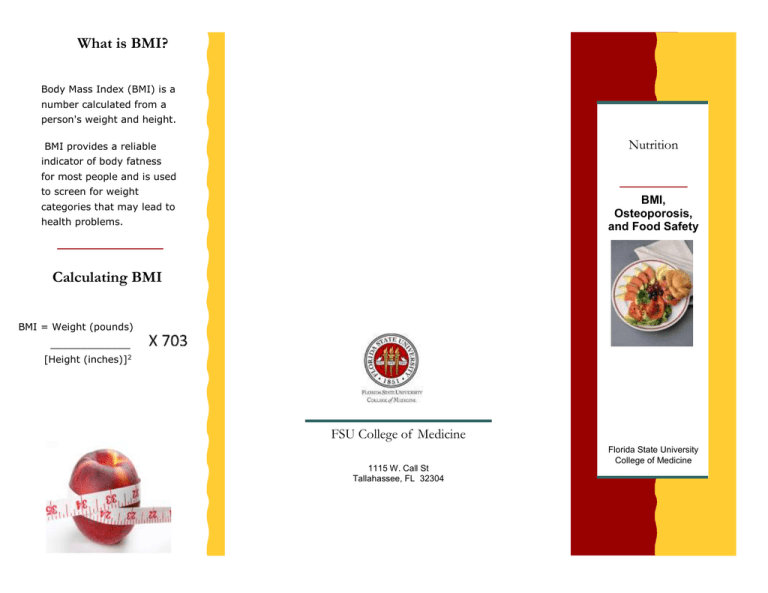What is BMI? Nutrition
advertisement

What is BMI? Body Mass Index (BMI) is a number calculated from a person's weight and height. Nutrition BMI provides a reliable indicator of body fatness for most people and is used to screen for weight BMI, Osteoporosis, and Food Safety categories that may lead to health problems. Calculating BMI BMI = Weight (pounds) _____________ [Height (inches)]2 FSU College of Medicine 1115 W. Call St Tallahassee, FL 32304 Florida State University College of Medicine Understanding BMI BMI is an estimate of body fat and a good gauge of your risk for diseases that can occur with more body fat. The higher your BMI, the higher your risk for certain diseases such as heart disease, high blood pressure, type 2 diabetes, gallstones, breathing problems, and certain cancers. Although BMI can be used for most men and women, it does have some limits: It may overestimate body fat in athletes and others who have a muscular build. It may underestimate body fat in older persons and others who have lost muscle. BMI Result Below 18.5 Underweight 18.5-24.9 Healthy 25 – 29.9 Overweight 30 and Above Obese Osteoporosis Food Safety Risky Foods What? Osteoporosis is a bone characterized by low bone density. It often results in fragile bones and increased risk for hip and back fractures. It can often have no symptoms until there is a fracture. -Meats, seafood, or poultry that are raw or undercooked -Unpasteurized dairy products or juices -Hot dogs, cold-cuts, and dry or fermented sausage if not reheated Who? Tips If you are… -have a family history of osteoporosis or bone fracture/fragility -older age -low BMI (less than 20) -use tobacco -have kidney stone disease …you should get tested. -Wash hands for 20 seconds with warm soapy water before and after meal preparation Prevention Weight Bearing Exercise -walking, hiking, jogging, dancing, lifting weights, etc. Vitamin D Supplements -no more than 800 IU/day Calcium- 1500 mg/day -orange juice, cheese, milk, yogurt -Keep a thermometer handy -meats-180°F -other meats, eggs, and casseroles- 160°F -ALL foods should be reheated to 165°F -Check the refrigerator and freezer at the beginning of every week and discard expired items -Use a separate area for meat and vegetables when cooking, and be sure to sanitize both areas when done These tips and more at http://www.caring.com/articles/el derly-food-safety-10-tipsguidelines-for-the-elderly



